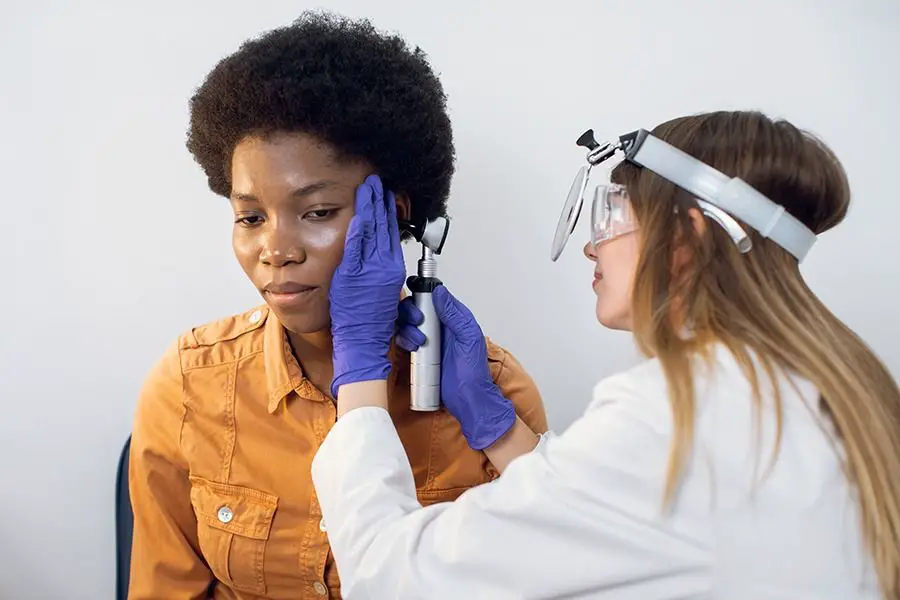Otosclerosis, a condition affecting the middle ear’s tiny bones known as ossicles, is a progressive disease leading to hearing impairment. It stands as one of the primary causes of hearing loss in adults. The exploration of otosclerosis offers a captivating historical narrative.
The Anatomy and Physiology of Otosclerosis
Before we delve further into Otospongiosis, let’s take a moment to understand the stage where this story unfolds – the ear. The ear, a marvel of nature’s engineering, is divided into three sections: the outer ear, the middle ear, and the inner ear. Sounds journey through these sections, transformed from mere air vibrations into comprehensible signals that the brain can interpret.
In the case of Otospongiosis, the plot thickens in the middle ear, specifically around the stapes, the smallest bone in the human body. An abnormal growth begins to form around this bone, causing it to become less mobile over time. As the stapes loses its ability to vibrate freely, the transmission of sound waves to the inner ear is hindered, resulting in hearing loss.
If Otospongiosis progresses, this abnormal bone growth can extend to the cochlea in the inner ear, a situation known as cochlear otosclerosis. This can lead to sensorineural hearing loss, which is associated with damage to the inner ear or the auditory nerve.
Historical Insights into Otosclerosis
The earliest known account of Otospongiosis dates to the 16th century, with Italian anatomist Girolamo Fabrici documenting a case involving ossicle hardening. In the 1800s, Johann Friedrich Dieffenbach, a German physician, coined the term “otosclerosis,” observing its prevalence in women and its association with deafness.
The 20th century brought various theories about Otospongiosis, initially attributing it to viral causes, a notion later debunked. By the 1950s, the hereditary nature of otosclerosis began to surface, leading to genetic research in the 1960s. A breakthrough came in the 1970s with the discovery of a collagen gene mutation causing the condition.
Otospongiosis is a relatively common disorder, affecting approximately 1-2% of the population. It is more common in women than in men, and the prevalence increases with age. In the United States, the prevalence of otosclerosis is highest among Caucasians, followed by African Americans and Hispanics.
The prevalence of Otospongiosis has remained relatively stable over the past few decades. However, there has been an increase in the number of cases in younger age groups, likely due to increased awareness and improved diagnosis.
Epidemiology of Otosclerosis
Otospongiosis affects about 1-2% of the population, more commonly in women, and its likelihood increases with age. In the U.S., Caucasians are most affected, followed by African Americans and Hispanics. While its overall prevalence has been stable, recent decades have seen a rise in diagnoses among younger individuals, thanks to better awareness and diagnostic methods.
The Evolution of Otosclerosis Treatment
Historically, Otospongiosis treatments have evolved significantly. The 19th century saw risky surgical removal of ossicles. The 20th century introduced antibiotics and steroids, which proved less effective. The advent of hearing aids in the 1950s and cochlear implants in the 1960s marked a new era in otosclerosis management.
Otosclerosis in Historical Figures
Otospongiosis has impacted many notable individuals. Ludwig van Beethoven, diagnosed in 1801, suffered profound hearing loss, affecting his music. Other prominent figures include Victor Hugo, Winston Churchill, and Franklin D. Roosevelt, all of whom battled this condition.
Conclusion
Otospongiosis presents a rich history from its initial descriptions to the discovery of its genetic underpinnings. It has influenced many, from famous composers to world leaders. The advancements in understanding and treating otosclerosis reflect the relentless pursuit of medical knowledge and the resilience of those affected. As research continues, the hope for better management and quality of life for those with otosclerosis grows.
-
Genome-wide screen of Otospongiosis in population biobanks: 27 loci and shared associations with skeletal structure – Published in Nature Communications, this study explores the pathophysiology of otosclerosis. It identifies 27 association loci and examines the shared associations with skeletal structure, providing new insights into the genetic factors of otosclerosis. Read the study here.
-
Conservative Otospongiosis Treatment With Sodium Fluoride and Other Modern Formulations: A Systematic Review – This systematic review, available on PMC – NCBI, discusses the effectiveness of treatments like etidronate for hearing stabilization in patients with otosclerosis. It provides a comprehensive analysis of current treatment options and their efficacy. Access the review here.
These references offer valuable information on the genetic understanding and treatment advancements of otosclerosis, which can be incorporated into the article for a more comprehensive and up-to-date perspective.






